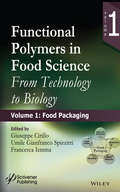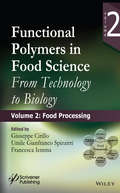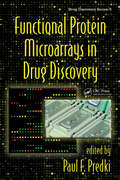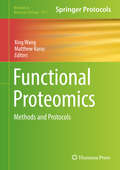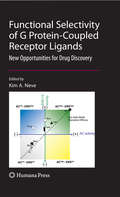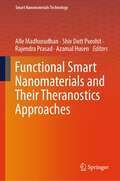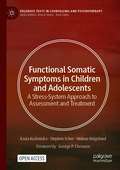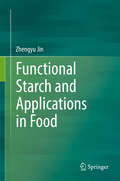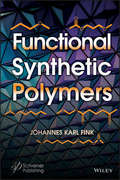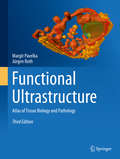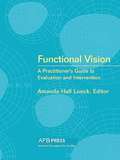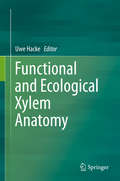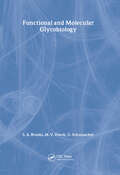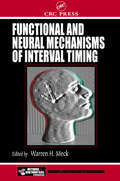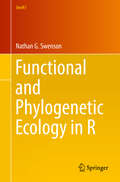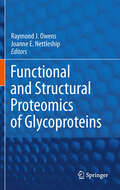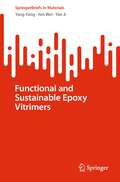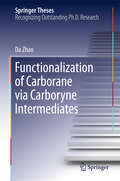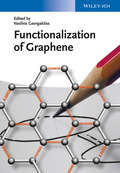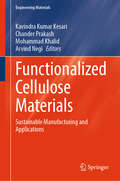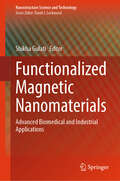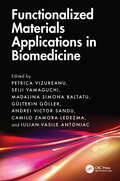- Table View
- List View
Functional Polymers in Food Science
by Francesca Iemma Umile Gianfranco Spizzirri Giuseppe CrilloPolymers are an important part in everyday life; products made from polymers range from sophisticated articles, such as biomaterials, to aerospace materials. One of the reasons for the great popularity exhibited by polymers is their ease of processing. Polymer properties can be tailored to meet specific needs by varying the "atomic composition" of the repeat structure, by varying molecular weight and by the incorporation (via covalent and non-covalent interactions) of an enormous range of compounds to impart specific activities. In food science, the use of polymeric materials is widely explored, from both an engineering and a nutraceutical point of view. Regarding the engineering application, researchers have discovered the most suitable materials for intelligent packaging which preserves the food quality and prolongs the shelf-life of the products. Furthermore, in agriculture, specific functionalized polymers are used to increase the efficiency of treatments and reduce the environmental pollution. In the nutraceutical field, because consumers are increasingly conscious of the relationship between diet and health, the consumption of high quality foods has been growing continuously. Different compounds (e.g. high quality proteins, lipids and polysaccharides) are well known to contribute to the enhancement of human health by different mechanisms, reducing the risk of cardiovascular disease, coronary disease, and hypertension. This first volume, of this two volume book, concerns the application of polymers in food packaging.
Functional Polymers in Food Science: From Technology to Biology, Volume 2: Food Processing (Polymer Science and Plastics Engineering)
by Francesca Iemma Giuseppe Cirillo Umile Gianfranco SpizzirriPolymers are an important part in everyday life; products made from polymers range from sophisticated articles, such as biomaterials, to aerospace materials. One of the reasons for the great popularity exhibited by polymers is their ease of processing. Polymer properties can be tailored to meet specific needs by varying the “atomic composition” of the repeat structure, by varying molecular weight and by the incorporation (via covalent and non-covalent interactions) of an enormous range of compounds to impart specific activities. In food science, the use of polymeric materials is widely explored, from both an engineering and a nutraceutical point of view. Regarding the engineering application, researchers have discovered the most suitable materials for intelligent packaging which preserves the food quality and prolongs the shelf-life of the products. Furthermore, in agriculture, specific functionalized polymers are used to increase the efficiency of treatments and reduce the environmental pollution. In the nutraceutical field, because consumers are increasingly conscious of the relationship between diet and health, the consumption of high quality foods has been growing continuously. Different compounds (e.g. high quality proteins, lipids and polysaccharides) are well known to contribute to the enhancement of human health by different mechanisms, reducing the risk of cardiovascular disease, coronary disease, and hypertension. This second volume focuses on the importance of polymers and functional food and in food processing
Functional Protein Microarrays in Drug Discovery (Drug Discovery Series)
by Paul F. PredkiAn ideal text for biotechnologists, protein chemists, and biochemists, Functional Protein Microarrays in Drug Discovery explores all aspects of functional protein microarrays, including basic principles, methods, and applications. The book discusses the generation of functional protein content and describes both standard and state-of-the-art fabrication methods. It reviews current and next generation approaches to assay detection and presents a wide range of applications, from biomolecular interaction discovery and characterization to immune response profiling. The book also addresses several fundamental computational issues, bioinformatics and data analysis.
Functional Proteomics: Methods and Protocols (Methods in Molecular Biology #1871)
by Xing Wang Matthew KurucThis book seeks to fill in the current technology gap with a specific collection of technologies developed for the study of protein function at a proteome scale. Chapters explore topics from protein functions to other aspects of protein analysis, especially in post-translational modification, as most proteomes use this mechanism in some capacity to carry out their unique role in cellular regulation. By comparing functional proteomes, this presents a bridge to other levels of system biology research including genomics and metabolomics in order to provide readers with a relatively complete picture for how one might study the biological system of their interest. Written in the highly successful Methods in Molecular Biology series format, chapters include introductions to their respective topics, lists of the necessary materials and reagents, step-by-step, readily reproducible laboratory protocols, and tips on troubleshooting and avoiding known pitfalls. Authoritative and cutting-edge, Functional Proteomics: Methods and Protocols collects these novel technologies in the hope that new frontiers in biological research will be created, important drug targets can be identified, and clinically validated biomarkers and diagnostic tests can be further developed.
Functional Renormalization and Ultracold Quantum Gases
by Stefan FlörchingerModern techniques from quantum field theory are applied in this work to the description of ultracold quantum gases. This leads to a unified description of many phenomena including superfluidity for bosons and fermions, classical and quantum phase transitions, different dimensions, thermodynamic properties and few-body phenomena as bound state formation or the Efimov effect. The non-perturbative treatment with renormalization group flow equations can account for all known limiting cases by solving one single equation. It improves previous results quantitatively and brings qualitatively new insights. As an example, new quantum phase transitions are found for fermions with three spin states. Ultracold atomic gases can be seen as an interesting model for features of high energy physics and for condensed matter theory. The research reported in this thesis helps to solve the difficult complexity problem in modern theoretical physics.
Functional Selectivity of G Protein-Coupled Receptor Ligands
by Kim NeveFunctional selectivity refers to the ability of different ligands acting at one receptor subtype to activate multiple signaling pathways in unique combinations; that is, one drug can be an agonist at pathway A and an antagonist or partial agonist at pathway B, and another drug can have the reverse profile. Functional selectivity has profound implications for drug development, for chemical biology, and for the design of experiments to characterize receptor function. In Functional Selectivity of G Protein-Coupled Receptors expert neuroscientists and pharmacologists review the work that demonstrated the existence of functional selectivity, placed it within a theoretical framework, and provided a mechanistic basis for the phenomenon. This exciting, comprehensive, and future-oriented volume includes chapters that focus on theoretical and mechanistic aspects of functional selectivity and that cut across subfamilies of GPCRs. Additional chapters focus on subfamilies of therapeutically relevant receptors where there is considerable evidence of ligand functional selectivity. Accessible and authoritative, Functional Selectivity of G Protein-Coupled Receptors is a valuable educational tool and reference source for students and scientists interested in drug development, chemical biology, and GPCR function.
Functional Smart Nanomaterials and Their Theranostics Approaches (Smart Nanomaterials Technology)
by Rajendra Prasad Azamal Husen Alle Madhusudhan Shiv Dutt PurohitThis book covers a number of engineered nanotheranostics platforms and nanomedicines applications of FDA-approved medicines for early-stage diagnosis and treatment of cancer. The book focuses on (i) the basic design and bioengineering of safe medicines, (ii) physicochemical understanding of surface engineered medicines and their characteristics, (iii) various examples for site-specific bioimaging and multimode therapies, (iv) stimuli-responsive approaches for targeted drug delivery applications, (v) targeted therapeutics approaches for cancer cells or solid tumor ablations, (vi) targeted mechanisms of administrative biomedicines, (vii) impact of surface modification or engineering of biomedicines for site-selective tumor binding ability, and (vii) requirements for clinical trials and FDA approval. The content of this book appeal to readers who are interested in recent developments of FDA-approved cost-effective rapid cancer imaging and therapeutic platforms.
Functional Somatic Symptoms in Children and Adolescents: A Stress-System Approach to Assessment and Treatment (Palgrave Texts in Counselling and Psychotherapy)
by Stephen Scher Kasia Kozlowska Helene HelgelandThis open access book sets out the stress-system model for functional somatic symptoms in children and adolescents. The book begins by exploring the initial encounter between the paediatrician, child, and family, moves through the assessment process, including the formulation and the treatment contract, and then describes the various forms of treatment that are designed to settle the child’s dysregulated stress system. This approach both provides a new understanding of how such symptoms emerge – typically, through a history of recurrent or chronic stress, either physical or psychological – and points the way to effective assessment, management, and treatment that put the child (and family) back on the road to health and well-being.
Functional Starch and Applications in Food
by Zhengyu JinThis book discusses functional starch and its applications in food, focusing on starches with possible health benefits or novel applications. Covering slowly digested starch, resistant starch, porous starch, starch microemulsions, microcrystalline starch and noncrystallization starch and their applications, this book provides a valuable reference for graduate students and research professionals in the food and chemical industries.
Functional Surfaces in Biology III: Diversity Of The Physical Phenomena (Biologically-Inspired Systems #10)
by Stanislav N. Gorb Elena V. GorbThis book is devoted to the rapidly growing area of science dealing with structure and properties of biological surfaces in their relation to particular functions. This volume, written by a team of specialists from different disciplines, covers various biological surface functions: sensing, coloration, attachment, drag reduction, moisture harvesting, etc. Because biological surfaces have a virtually endless potential of technological ideas for the development of new materials and systems, inspirations from biology could also be interesting for a broad range of topics in surface engineering. This volume together with two previous volumes “Functional Surfaces in Biology” (vols. 1 & 2 published in 2009) taken together, present a good reference for a novice in the field. The book is intended for use by researchers who are active, or intend to become active, in the field. The appeal of this topic is expected to be broad, ranging from classical biology, biomechanics and physics to such applied fields as materials science and surface engineering.
Functional Synthetic Polymers
by Johannes Karl FinkThe text focuses on the basic issues and also the literature of the past decade. The book provides a broad overview of functional synthetic polymers. Special issues in the text are: Surface functionalization supramolecular polymers, shape memory polymers, foldable polymers, functionalized biopolymers, supercapacitors, photovoltaic issues, lithography, cleaning methods, such as recovery of gold ions olefin/paraffin, separation by polymeric membranes, ultrafiltration membranes, and other related topics.
Functional Ultrastructure
by Jürgen Roth Margit PavelkaThis atlas provides a detailed insight into the complex structure and organization of cells and tissues, and highlights their specific functions as well as the dynamics of diverse intracellular processes. Highly informative electron micrographs are complemented by explanatory texts, selected references and schemes. The concept that subcellular organelles provide the structural foundation for fundamental processes of living organisms is emphasized. The first part covers the cellular organelles and changes caused by experiments or occurring under pathological conditions. The second part employs selected examples to illustrate the principles of functional tissue organization and typical changes resulting from experimental induction or pathological situations. The third edition of the atlas, revised and extended by 23 plates, thus provides an invaluable resource for scientists and students of medicine and biological sciences, particularly of histology, cell and molecular biology. Moreover, it will serve as a handy reference guide for diagnostic and research electron microscopy laboratories in clinical, industrial, and academic settings.
Functional Vision: A Practitioner's Guide To Evaluation And Intervention
by Amanda Hall LueckAn essential tool for anyone working in the area of low vision, Functional Vision presents a systematic, comprehensive, integrated approach to assessing an individuals functional vision and delivering the appropriate services determined by the assessment results. Based on groundbreaking work by distinguished professionals who have developed the specific principles and procedures for helping people of all ages with low vision, including those with multiple disabilities, the text explains how to link intervention to assessment findings and to teach compensatory skills through everyday activities at school, work, home, and in the community. This detailed and practical guide provides case examples, charts, figures, and sample forms that enable practitioners to apply expert methods in their work with clients
Functional and Ecological Xylem Anatomy
by Uwe HackeThe book will describe the xylem structure of different plant groups, and will put the findings in a physiological and ecological context. For instance, when differences in vessel diameter are featured, then there will be an explanation why this matters for water transport efficiency and safety from cavitation. The focus is on the hydraulic function of xylem, although mechanical support and storage will also be covered. Featured plant groups include ferns (which only have primary xylem), conifers (tracheid-based xylem), lianas (extremely wide and long vessels), drought-adapted shrubs as well as the model systems poplar and grapevine. The book chapters will draw on the expertise and cutting edge research of a diversified group of internationally known researchers working in different anatomical and physiological sub-disciplines. Over the last two decades, much progress has been made in understanding how xylem structure relates to plant function. Implications for other timely topics such as drought-induced forest dieback or the regulation of plant biomass production will be discussed.
Functional and Molecular Glycobiology
by Udo Schumacher Dr Susan Brooks Dr M DwekFunctional and Molecular Glycobiology explains the chemistry of carbohydrates, and the biosynthesis and diversity of different types of glycans. It looks at the functional role of glycoconjugate compounds in normal cellular processes, in both disease and development. The book also describes how these compounds can be studied, analysed and manipulated for use in biotechnology. Functional and Molecular Glycobiology is a unique introduction to the field bridging the gap between introductory books and current research.
Functional and Neural Mechanisms of Interval Timing (Frontiers in Neuroscience)
by Warren H. MeekUnderstanding temporal integration by the brain is expected to be among the premier topics to unite systems, cellular, computational, and cognitive neuroscience over the next decade. The phenomenon has been studied in humans and animals, yet until now, there has been no publication to successfully bring together the latest information gathered from
Functional and Phylogenetic Ecology in R
by Nathan G. SwensonFunctional and Phylogenetic Ecology in R is designed to teach readers to use R for phylogenetic and functional trait analyses. Over the past decade, a dizzying array of tools and methods were generated to incorporate phylogenetic and functional information into traditional ecological analyses. Increasingly these tools are implemented in R, thus greatly expanding their impact. Researchers getting started in R can use this volume as a step-by-step entryway into phylogenetic and functional analyses for ecology in R. More advanced users will be able to use this volume as a quick reference to understand particular analyses. The volume begins with an introduction to the R environment and handling relevant data in R. Chapters then cover phylogenetic and functional metrics of biodiversity; null modeling and randomizations for phylogenetic and functional trait analyses; integrating phylogenetic and functional trait information; and interfacing the R environment with a popular C-based program. This book presents a unique approach through its focus on ecological analyses and not macroevolutionary analyses. The author provides his own code, so that the reader is guided through the computational steps to calculate the desired metrics. This guided approach simplifies the work of determining which package to use for any given analysis. Example datasets are shared to help readers practice, and readers can then quickly turn to their own datasets.
Functional and Structural Proteomics of Glycoproteins
by Raymond J. Owens Joanne E. NettleshipIt has been predicted that nearly half of all human proteins are glycosylated indicating the significance of glycoproteins in human health and disease. For example, the glycans attached to proteins have emerged as important biomarkers in the diagnosis of diseases such as cancers and play a significant role in how pathogenic viruses gain entry into human cells. The study of glycoproteins has now become a truly proteomic science. In the last few years, technology developments including in silico methods, high throughput separation and detection techniques have accelerated the characterization of glycoproteins in cells and tissues. Glyco-engineering coupled to rapid recombinant protein production has facilitated the determination of glycoprotein structures key to exploring and exploiting their functional roles. Each chapter in this volume is written by experts in the field and together provide a review of the state of the art in the emerging field of glycoproteomics.
Functional and Sustainable Epoxy Vitrimers (SpringerBriefs in Materials)
by Yang Yang Yan Ji Yen WeiThis book summarizes recent advances in epoxy vitrimer research, giving thorough discussion of the classification and fabrication of epoxy vitrimers and their composites. Epoxy vitrimers are reversible covalently crosslinked networks with dynamic covalent bonds, combining the excellent mechanical properties of thermosets with the re-processability of thermoplastics. The authors explore and summarize many current and potential applications of epoxy vitrimer composites across the domains of aerospace materials, electronic devices, machine manufacturing, and consumer products and technology. This book serves as an accessible introduction and a helpful guide to graduate students, researchers, and industry professionals in materials science and engineering with an interest in advanced polymer composites.
Functionalisation of Heterocycles through Transition Metal Catalyzed C-H Activation (Topics in Heterocyclic Chemistry #60)
by Debabrata Maiti Upendra SharmaIn this book, recent advancements in the heterocycles functionalization by using different transition metals have been described. Heterocycles are the central point mainly in drug discovery and various other fields. The ease with which one can functionalize these scaffolds mainly accounts for the whole process output. In the last three decades, C-H activation has emerged as the sustainable and economic way to functionalize the heterocycles. Numerous catalytic methods have been developed and are being developed by applying mainly transition metals. The books main emphasis has been given to mechanistic aspects and the application of developed methodologies for the functionalization of natural scaffolds. The book is useful for researchers who are working in the area of C-H activation/functionalization in academia and industry.
Functionalization of Carborane via Carboryne Intermediates
by Da ZhaoThis thesis focuses on the development of new methods of functionalizing carboranes using o-carboryne intermediates. Functional carboranes are now finding a broad range of applications, including organic synthesis, drug design, polymers, catalysis, metal−organic frameworks, electronic devices and more. However, the limited number of efficient synthetic methods for obtaining functional carborane materials has restricted their applications. The methodologies established in this thesis represent simple, yet powerful strategies to assemble previously inaccessible, useful complex molecules, which will also have a significant impact on future synthetic, cluster and materials chemistry. Moreover, it discusses the first method for the in situ generation of electrophilic boron radical using photocatalysis.
Functionalization of Graphene
by Vasilios GeorgakilasAll set to become the standard reference on the topic, this book covers the most important procedures for chemical functionalization, making it an indispensable resource for all chemists, physicists, materials scientists and engineers entering or already working in the field. Expert authors share their knowledge on a wide range of different functional groups, including organic functional groups, hydrogen, halogen, nanoparticles and polymers.
Functionalized Cellulose Materials: Sustainable Manufacturing and Applications (Engineering Materials)
by Kavindra Kumar Kesari Chander Prakash Mohammad Khalid Arvind NegiThis book explores the innovative landscape of functionalized cellulose materials, emphasizing sustainable manufacturing practices and their wide-ranging applications. Advanced functional materials have seen extensive utilization across various sectors, including food processing, pharmaceuticals, cosmetics, electronics, textiles, environmental management, healthcare, and energy, all of which align with the Sustainable Development Goals (SDGs). These materials can be synthesized from both organic (primarily plant-based) and inorganic sources, utilizing sustainable biomass such as wheat, rice straw, wood fibers, and other renewable resources, with or without the incorporation of polymers and nanomaterials. Featuring contributions from leading international researchers, this book provides a comprehensive overview of current challenges and advances in materials science and advanced manufacturing across diverse industries, including cellulose films, aerospace, automotive, marine, and biomedical fields. It covers state-of-the-art topics such as additive manufacturing, 3D printing, bio-manufacturing, and intelligent manufacturing systems. The book highlights key innovations and practical applications of cellulose-based functionalized materials, such as hydrogels, drug delivery platforms, and biomaterials. This field continues to expand through interdisciplinary collaboration, fostering advancements in green chemistry, sustainable manufacturing practices, and materials engineering while addressing pressing challenges in sustainability and circular economy frameworks.
Functionalized Magnetic Nanomaterials: Advanced Biomedical and Industrial Applications (Nanostructure Science and Technology)
by Shikha GulatiThis contributed volume discusses advanced applications of functionalized magnetic nanomaterials (FMNs) across biomedical and industrial sectors, exploring their innovative uses in drug delivery, diagnostic imaging, water treatment, and energy technologies. It highlights the interdisciplinary nature of FMNs, examining their roles in cancer treatment, biosensing, and waste management, while also addressing regulatory, economic, and safety aspects. Through case studies and a focus on future trends, the book provides a comprehensive understanding of FMNs' potential to transform various fields. The intended audience includes researchers, professionals, and students in materials science, biomedical engineering, environmental science, and industrial technology.
Functionalized Materials Applications in Biomedicine
by Petrica Vizureanu Andrei Victor Sandu Seiji Yamaguchi Madalina Simona Baltatu Gültekin Göller Camilo Zamora-Ledezma Iulian-Vasile AntoniacThis book offers an in-depth exploration of biomaterials with a primary focus on recent developments. It begins by providing a comprehensive background on the basic principles of biomaterials, followed by the synthesis, properties, and performance of various biomaterials. Subsequent chapters discuss topics such as biocompatibility, the interaction of biomaterials with the human body, and the role of biomaterials in regenerative medicine. It also addresses the technological advancements in biomaterials, novel fabrication methods, and surface modification techniques backed by case studies.Features: Presents the latest advancements in biomaterials, including novel fabrication methods, innovative materials, and groundbreaking applications in medical devices and regenerative medicine Offers a holistic view of the biomaterials field, bridging various disciplines such as biology, chemistry, materials science, and medicine Illustrates practical applications of biomaterials in tissue engineering, drug delivery systems, and medical imaging Delves into the ethical, regulatory, and commercial dimensions of biomaterials Includes detailed case studies on topics such as thermal properties, corrosion resistance, and industrial coatings This book is aimed at researchers and graduate students of bioengineering, biomaterials, and materials science.
